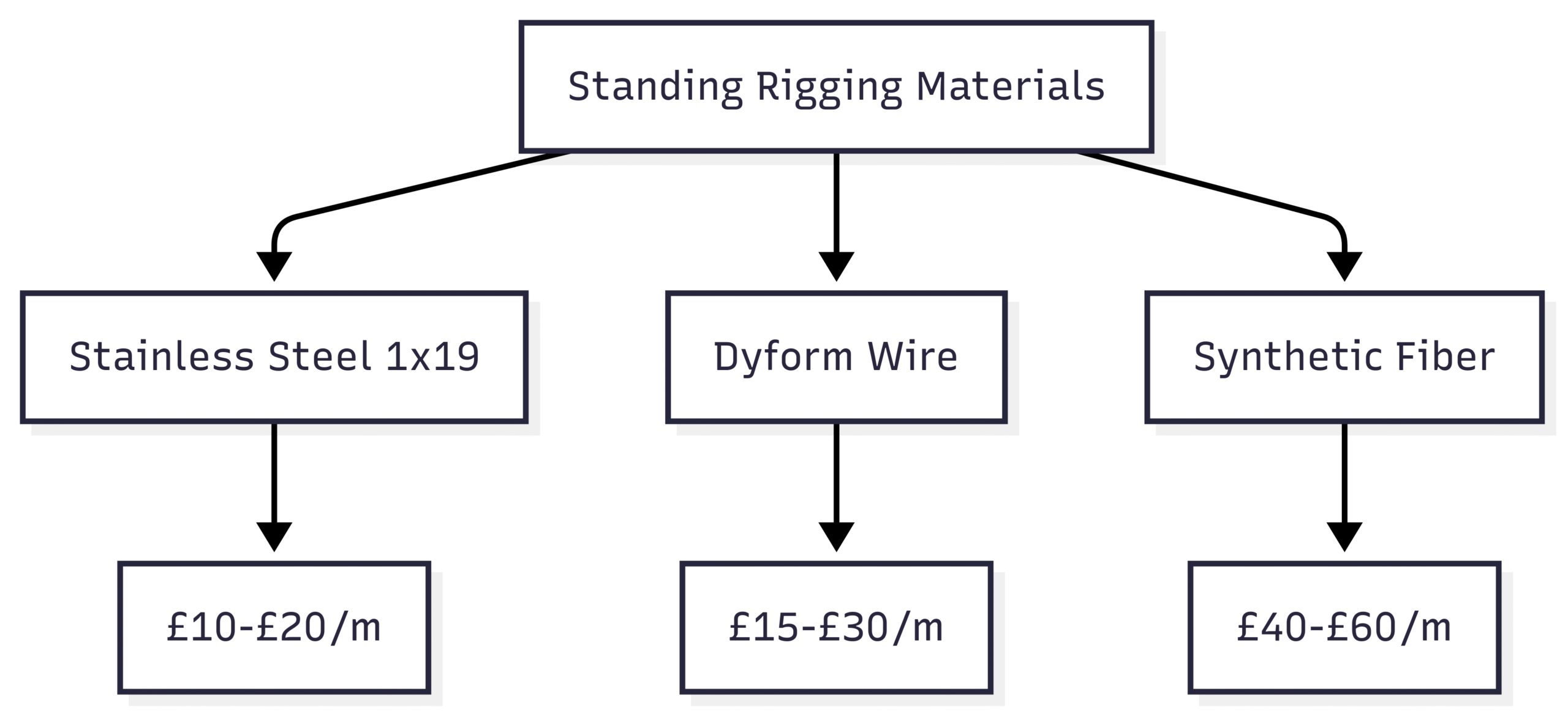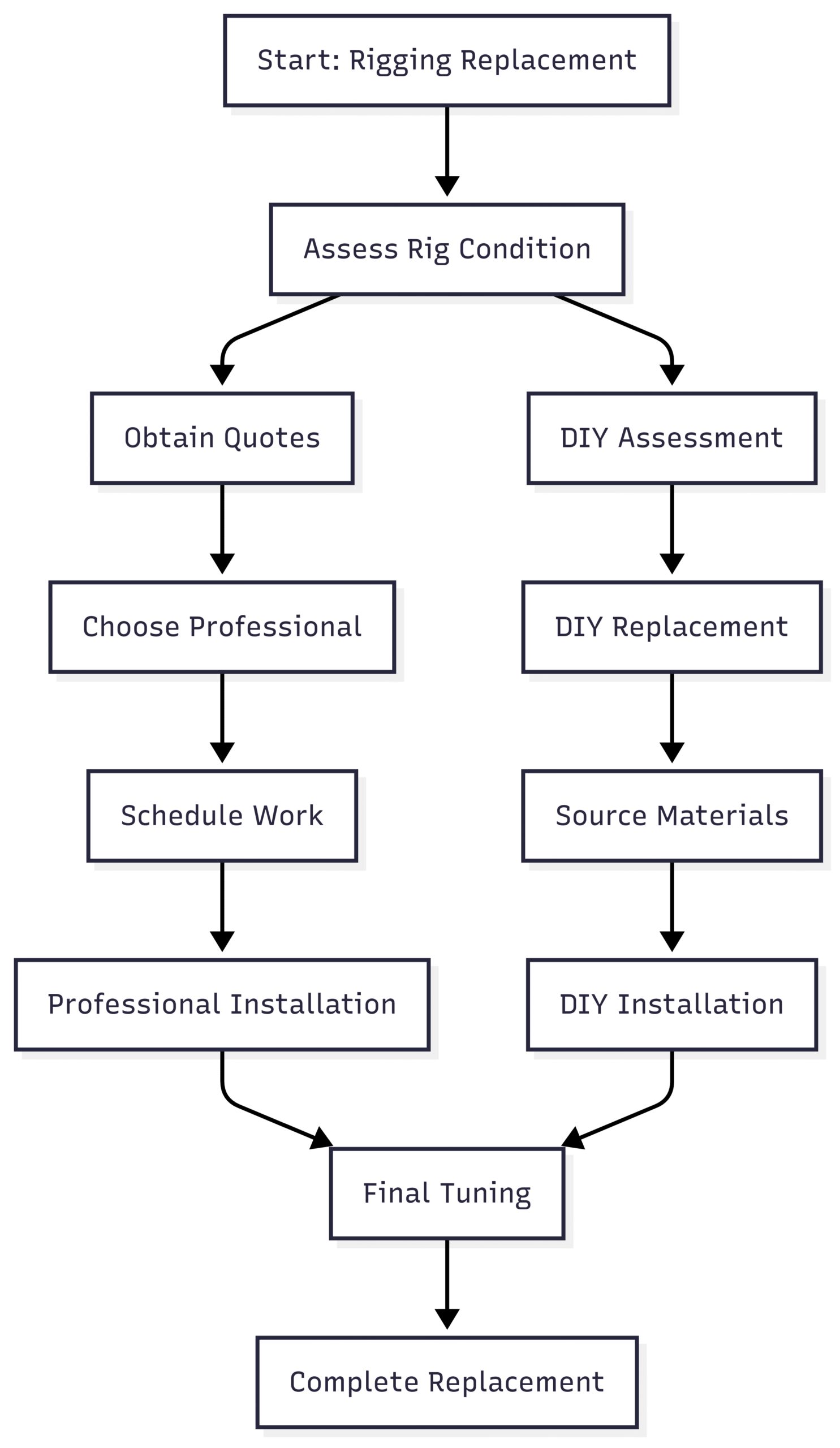Exact Cost to Replace Standing Rigging in the UK
Discover the exact cost to replace standing rigging in the UK, from £1,000-£7,000, based on boat size, materials, and DIY vs. professional options.
Standing rigging is the backbone of a sailboat’s stability, ensuring the mast remains upright and secure under sail. Over time, wear from weather, saltwater, and mechanical stress can degrade rigging components, necessitating replacement to maintain safety and performance. In the UK, the cost to replace standing rigging varies widely based on boat size, rig complexity, material choices, and whether you opt for professional services or a DIY approach. This guide provides a detailed breakdown of these costs, factors influencing them, and practical advice for boat owners, aiming to help you make informed decisions for your vessel.
Understanding Standing Rigging and Its Importance
Standing rigging refers to the fixed lines, cables, and fittings that support a sailboat’s mast. These include stays (forestay and backstay) and shrouds, typically made from stainless steel wire or synthetic fibers like Dyneema. Regular replacement—often recommended every 10-15 years by insurers—prevents catastrophic failures, such as mast loss, which can be costly and dangerous. Costs in the UK typically range from £1,000 to £7,000, with smaller boats (20-30 feet) at the lower end and larger yachts (40-50 feet) at the higher end. The following sections explore the factors driving these costs and provide actionable insights.
Factors Influencing Replacement Costs
Several variables determine the cost of replacing standing rigging. Understanding these factors helps you anticipate expenses and make cost-effective choices.
Boat Size and Rig Complexity
The size of the boat and the complexity of its rig significantly impact costs. Larger boats require longer wires, larger-diameter cables, and more fittings, increasing material and labor expenses. For example:
- Small sailboats (20-30 feet): These typically have simpler single-spreader rigs, requiring less material. Costs range from £1,000 to £2,500 for materials and labor.
- Medium sailboats (30-40 feet): These often feature double-spreader or cutter rigs, increasing complexity. Costs range from £2,500 to £4,500.
- Large sailboats (40-50 feet): Complex rigs with multiple stays and shrouds push costs to £4,500-£7,000, with some high-performance yachts exceeding £10,000.
Rig type also matters. A cutter rig, with additional stays, requires more materials than a sloop rig. Taller masts or multiple sails further complicate installation, adding to labor time.
Material Choices
The choice of rigging material affects both cost and longevity. Common options include:
- Stainless Steel 1×19 Wire: Widely used for its strength and affordability, costing £10-£20 per meter. It’s durable but prone to corrosion in saltwater, requiring regular inspection.
- Dyform Wire: A higher-grade stainless steel with better corrosion resistance and strength, priced at £15-£30 per meter. It’s popular for performance yachts.
- Synthetic Fiber (e.g., Dyneema): Lightweight and UV-resistant, Dyneema costs £40-£60 per meter. Its higher initial cost is offset by low maintenance and a longer lifespan.
Additional components, such as swaged or swageless terminals, also influence costs. Swageless fittings, which allow DIY assembly, are more expensive but reusable, while swaged terminals require professional crimping.
Turnbuckles and Fittings
Turnbuckles, which adjust rigging tension, vary in cost based on material and condition. Open bronze turnbuckles are often replaced during rigging overhauls (£50-£150 each), while stainless steel closed-body turnbuckles may be reused if in good condition. Other fittings, like chainplates and tangs, may need replacement if corrosion or wear is evident, adding £100-£500 to the total.
Professional Installation vs. DIY
Hiring a professional rigger ensures precision and safety but increases costs. Labor rates in the UK average £50 per hour, with a full replacement for a 30-foot boat taking 6-12 hours. DIY replacement can save 30-50% but requires skill, time, and access to tools like swaging machines or cranes. Risks include improper tensioning, which can compromise rig stability.
Additional Costs
Other expenses to consider include:
- Mast Removal and Stepping: If the mast must be unstepped, crane hire and boatyard fees range from £300-£600.
- Furler Systems: Replacing or servicing roller furlers (e.g., Profurl or Bamar) adds £500-£1,500.
- Chainplates and Hardware: Inspecting and replacing chainplates or other fittings can cost £100-£1,000.
- Storage Fees: Storing the mast ashore during replacement may incur additional charges, typically £50-£200.
Insurance Requirements
Many UK insurance providers require standing rigging replacement every 10-15 years or a professional inspection to maintain coverage. Some policies demand non-destructive testing (NDT) for older rigs, which can cost £500-£1,000 for a 30-foot yacht. Always check your policy to ensure compliance.
Cost Breakdown by Boat Size
The following table summarizes approximate costs for standing rigging replacement in the UK, based on boat size and professional installation (including materials and labor):
| Sailboat Size | Cost Range | Example Boats |
|---|---|---|
| Small (20-30 ft) | £1,000 – £2,500 | Hunter Sonata 23, Westerly Centaur |
| Medium (30-40 ft) | £2,500 – £4,500 | Sigma 33, Dufour 36cc |
| Large (40-50 ft) | £4,500 – £7,000 | Bowman 40, Moody 47 |
Examples from UK Suppliers
Petersen Custom Rigging provides the following supply-only quotes for specific boats, excluding labor and additional services:
- Hunter Sonata (23 ft): £605
- Westerly Centaur (26 ft): £936
- Sigma 33 OOD (33 ft): £1,620
- Dufour 36cc (36 ft): £2,820
- Westerly Typhoon (37 ft): £3,389
- Bowman 40 (40 ft): £5,995
- Moody 47 (47 ft): £6,110
These prices reflect materials only (e.g., 1×19 stainless steel wire, swaged terminals, and turnbuckles). Adding professional installation typically increases costs by £500-£2,000, depending on boat size and rig complexity.
Cost by Material Type
Material choice significantly impacts the budget. Below is a comparison of common rigging materials and their costs per meter:
| Material | Price Range per Meter | Pros | Cons |
|---|---|---|---|
| Stainless Steel 1×19 Wire | £10 – £20 | Affordable, strong | Prone to corrosion, requires maintenance |
| Dyform Wire | £15 – £30 | Corrosion-resistant, high strength | More expensive than 1×19 wire |
| Synthetic Fiber (e.g., Dyneema) | £40 – £60 | Lightweight, low maintenance, durable | High initial cost |
Chart: Material Cost Comparison

This chart illustrates the cost hierarchy, with synthetic fibers being the most expensive but offering long-term savings due to durability.
Cost by Rigging Company
Several reputable UK companies provide rigging replacement services. Below are estimated costs for professional replacement, including materials and labor:
| Company | Estimated Cost | Services Offered |
|---|---|---|
| Allspars | £3,000 – £5,000 | Standing rigging, mast repairs, 24/7 emergency |
| Selden Mast | £2,500 – £4,500 | Rigging replacement, tuning, global network |
| Hamble Yacht Services | £3,000 – £5,000 | Full yacht maintenance, rigging, and tuning |
Choosing a Rigging Company
When selecting a rigger, consider:
- Reputation: Check reviews and ask for references from other boat owners.
- Scope of Work: Ensure quotes include all necessary services (e.g., tuning, inspections).
- After-Sales Support: Companies like Allspars offer emergency services, which can be valuable.
- Location: Local riggers may reduce travel costs. For example, Hamble Yacht Services is ideal for South Coast sailors.
Always obtain multiple quotes to compare pricing and services. Online forums, such as YBW or sailing club communities, are excellent resources for recommendations.
DIY vs. Professional Replacement: Pros and Cons
Deciding between DIY and professional replacement depends on your skills, time, and budget. Below is a detailed comparison:
Pros and Cons of DIY Replacement
| Aspect | Pros | Cons |
|---|---|---|
| Cost | Saves 30-50% (£400-£1,500 for small boats) | Hidden costs (e.g., tools, crane hire) |
| Convenience | Flexible timing, learning experience | Time-consuming, requires technical knowledge |
| Safety | Full control over process | High risk of errors, potential rig failure |
| Equipment | Uses existing tools if available | Limited access to specialized tools (e.g., swaging machines) |
Cost Comparison: DIY vs. Professional
| Boat Size | DIY Cost | Professional Cost |
|---|---|---|
| Under 30 ft | £400 – £1,500 | £1,000 – £3,000 |
| 30-50 ft | £1,500 – £3,000 | £2,000 – £6,000 |
DIY Safety Considerations
DIY replacement can be rewarding but risky. Follow these tips to minimize hazards:
- Assess Skills: Be honest about your technical ability. If unsure, consult a professional for critical steps like tensioning.
- Use Proper Tools: Invest in or rent appropriate equipment, such as swageless fitting tools or a tension gauge.
- Double-Check Work: Inspect all fittings and connections before stepping the mast.
- Seek Guidance: Online forums (e.g., YBW) and local sailing clubs offer valuable advice from experienced sailors.
Case Study: DIY Replacement on a Hanse 311
A Hanse 311 owner replaced their rigging in 2022 for £1,070 (excluding forestay and furler). They used a local rigger to supply materials and performed the installation themselves, saving on labor costs. The mast was already down, avoiding crane fees. This approach required careful measurement and familiarity with swageless fittings but resulted in significant savings.
Real-World Experiences from UK Sailors
Insights from sailing forums provide practical perspectives on rigging replacement costs and strategies:
- Hanse 312 (20 years old): A sailor reported a quote of £1,200 for materials and labor from a local rigger, excluding mast stepping. They opted for professional installation due to the boat’s age and insurance requirements.
- Seamaster 925 (30 ft): A West Coast Scotland rigger charged £1,200 for 7 6mm wires, including bottle screws and tuning, demonstrating regional price variations.
- Moody 31: A professional replacement cost £1,610, including minor repairs like a worn halyard deflector, highlighting the importance of inspecting associated hardware.
- Hanse 315 (2007): A DIY replacement with Dyneema backstay adjusters cost £1,000 for materials, with crane hire at £300-£400. The owner emphasized the ease of splicing Dyneema for custom setups.
These examples underscore the importance of tailoring your approach to your boat’s needs and your skill level.
Strategies to Save on Replacement Costs
To minimize expenses without compromising safety:
- Get Multiple Quotes: Contact at least three riggers to compare pricing and services.
- Consider Partial Replacement: If only certain stays or shrouds show wear (e.g., rust at bottle screws), replace those instead of the entire rig.
- Opt for DIY Where Feasible: Handle tasks like measuring or removing old rigging to reduce labor costs.
- Choose Cost-Effective Materials: Stainless steel 1×19 wire is sufficient for most cruising boats, while Dyneema is better for performance yachts.
- Maintain Regularly: Inspect rigging annually to catch issues early, potentially extending its lifespan.
Chart: Replacement Process Flow

This flowchart outlines the decision-making process, from assessment to completion, helping you navigate DIY or professional options.
Hidden Costs to Watch For
Unexpected expenses can inflate your budget. Common hidden costs include:
- Chainplate Replacement: Corrosion or fatigue may require new chainplates (£100-£500).
- Furler Servicing: Stiff or damaged furlers (e.g., Facnor, Furlex) may need repair or replacement (£500-£1,500).
- Mast Repairs: Worn fittings, like halyard deflectors, may only be discovered when the mast is down (£50-£200).
- Boatyard Fees: Haul-out, storage, or crane hire can add £300-£600.
Conclusion
Replacing standing rigging in the UK is a significant but necessary investment to ensure your sailboat’s safety and performance. Costs range from £1,000 for small boats to over £7,000 for larger yachts, driven by factors like boat size, material choice, and labor. DIY replacement can save money but requires skill and caution, while professional services offer reliability at a higher cost. By understanding these factors, obtaining multiple quotes, and considering long-term material benefits (e.g., Dyneema’s durability), you can make informed decisions that balance cost and quality. Regular maintenance and timely replacements will keep your boat sailing safely for years to come.
Happy Boating!
Share Exact Cost to Replace Standing Rigging in the UK with your friends and leave a comment below with your thoughts.
Read Exact Cost to Replace Standing Rigging in Australia until we meet in the next article.







Thanks for sharing. I read many of your blog posts, cool, your blog is very good.
The post provides a clear and detailed breakdown of the costs to replace standing rigging in the UK, offering useful insights for anyone planning this type of maintenance.